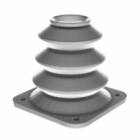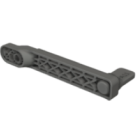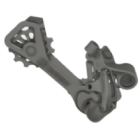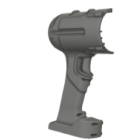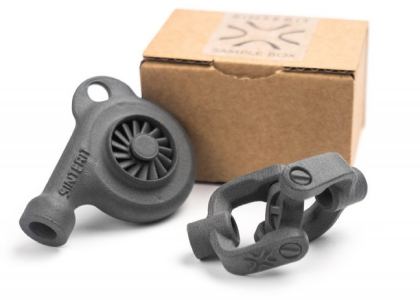Next-generation 3D printing materials
As 3D printing matures, materials are no longer an afterthought — they’re at the forefront of innovation. Early additive manufacturing revolved around standard plastics like PLA or ABS. Today, new generations of engineered polymers, composites, metals, and even bio-based materials are redefining what’s possible. Emerging categories such as nanocomposites, conductive polymers, and gradient alloys are enabling multifunctional designs where a single printed part integrates mechanical, electrical, and thermal properties. These advanced materials don’t just expand functionality; they also close the performance gap between printed parts and traditionally manufactured components.
Next-generation materials are enabling new applications, solving previous design limitations, and pushing 3D printing deeper into production environments — from aerospace and automotive to electronics, medicine, and energy.
High-performance polymers
Engineering-grade thermoplastics like PA11, PA12, PEKK, PEEK, and PPSU are paving the way for demanding applications. These materials offer high temperature resistance, chemical stability, and excellent mechanical properties. For example, PEKK and PEEK are suitable for aerospace and medical implants due to their biocompatibility and extreme thermal tolerance. Their printability is improving, especially in high-temperature FDM and powder bed systems, making them more accessible than ever. New process innovations, such as controlled chamber heating and multi-zone extrusion heads, are helping mitigate issues like warping and interlayer adhesion that historically limited high-performance polymer printing.
Sustainable polymers are also gaining traction. Bio-based nylons, recycled PA materials, and degradable composites are entering the market, helping manufacturers meet environmental goals without sacrificing part performance. In Europe, PA11 derived from castor oil and recycled PA12 blends are gaining industrial adoption, offering a lower carbon footprint while maintaining mechanical stability in SLS systems.
Composites and reinforced materials
The next wave of additive materials includes carbon fiber, glass fiber, and even aramid-reinforced composites. These filaments or powders enhance stiffness, reduce weight, and introduce superior fatigue resistance.
Rather than replacing metals, these materials aim to combine the best of both worlds — the design freedom of polymers with the mechanical strength of traditional engineering alloys. Composite powders are also emerging in SLS, allowing large-format and load-bearing parts to be printed without tooling. Continuous fiber reinforcement is also advancing, with automated fiber placement and hybrid extrusion systems enabling composites that rival aluminum in stiffness-to-weight ratio.
Metal alloys: new grades and hybrid possibilities
Metal 3D printing is evolving rapidly, not just in process control but in available alloy chemistries. Titanium and aluminum alloys remain popular in aerospace and automotive due to their strength-to-weight ratio, but new specialty materials are entering the field:
- copper alloys for high-conductivity components like heat exchangers,
- inconel for extreme heat and corrosion resistance,
- tool steels and maraging steels for industrial tooling and molds.
Emerging aluminum-scandium alloys and titanium-aluminum-vanadium variants are offering improved printability and crack resistance, addressing long-standing challenges in laser-based metal AM.
In addition, researchers are exploring multi-material printing, combining different metals or alloys in a single print to achieve gradient properties or embedded functionalities, such as conductive tracks within structural parts — a key enabler for functionally graded materials (FGMs) and integrated electronic-mechanical systems.
Smart and functional materials
One of the most exciting areas in next-generation 3D printing is the development of functional materials that go beyond mechanical strength:
- conductive materials for printed electronics, antennas, and embedded sensors,
- shape memory polymers that change shape when triggered by heat or current,
- magnetic and piezoelectric materials used in soft robotics and actuators,
- self-healing resins that can repair micro-cracks without human intervention.
Researchers are also experimenting with photonic and thermochromic materials that respond to light or temperature changes, opening possibilities for sensors, adaptive optics, and color-changing surfaces. These smart materials are the bridge between additive manufacturing and applications in IoT devices, soft robotics, biomedical implants, and adaptive structures.
Material informatics and AI-guided development
Another game-changer is how materials are discovered and optimized. Machine learning and AI-driven platforms are being used to accelerate material discovery, simulate performance, and tailor formulations to specific printing technologies. Digital material twins — virtual representations of material behavior under various process conditions — are enabling faster iteration and predictive qualification for industrial AM. This means that in the near future, we may see materials designed algorithmically to match target performance requirements — even before the first test print is done.
Outlook: materials drive the future of AM
The materials landscape in 3D printing is expanding from commodity plastics into tailored, functional, and high-performance domains. While printers themselves are evolving, it’s the materials — with smarter formulations and broader capabilities — that will ultimately determine where additive manufacturing can go next. As open material platforms gain traction, collaboration between printer manufacturers, chemical companies, and AI developers will accelerate the pace of material innovation even further.
From lightweight aerospace structures to biodegradable consumer products, next-gen materials unlock the next chapter in industrial 3D printing. They’re not just improving performance — they’re redefining the boundaries of what we can manufacture.
Explore also
- Is 3D printing the future?
- What is the future of 3D printing?
- Future uses of 3D printing
- 3D printing vs traditional manufacturing
- What will 3D printers be used for in the future
- Trends in additive manufacturing
- AI in 3D printing
- Automation 3D printing
Related categories




